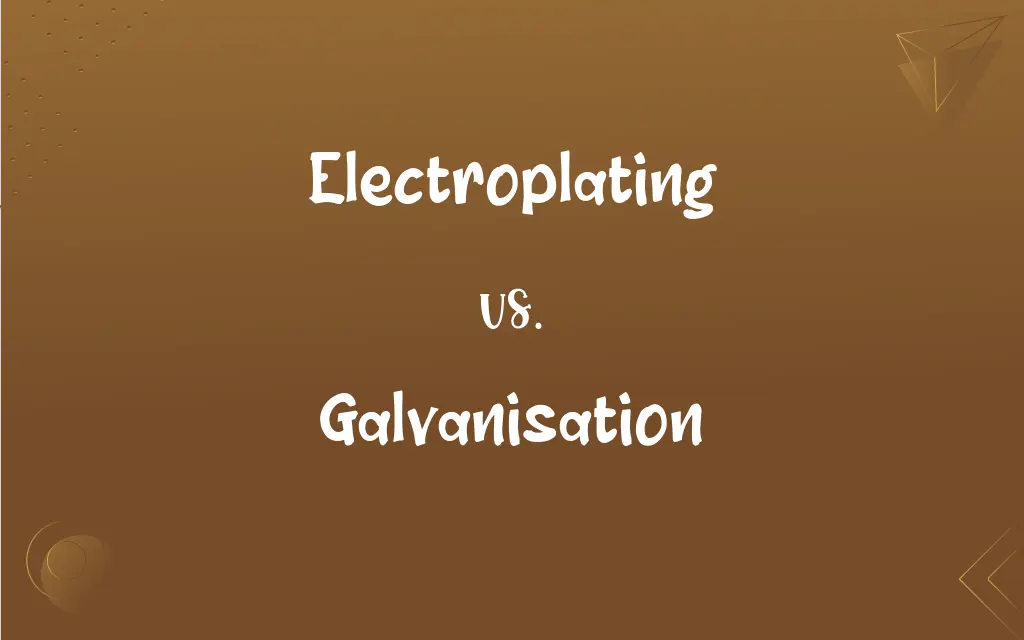Electroplating vs. Galvanisation: What's the Difference?
Edited by Harlon Moss || By Janet White || Published on December 3, 2023
Electroplating involves depositing a thin metal layer on an object using an electrical current, while galvanisation is coating iron or steel with zinc for corrosion protection.

Key Differences
Electroplating uses an electric current to reduce dissolved metal cations, enabling them to form a coherent metal coating on an electrode; while, galvanisation involves applying a protective zinc coating to steel or iron to prevent rusting.
Galvanisation typically refers to hot-dip galvanizing, a process where steel is submerged in molten zinc; however, electroplating often involves a more controlled and precise deposition of metal layers, used for both functional and decorative purposes.
In electroplating, the thickness and composition of the metal layer can be tightly controlled, making it ideal for electronic components; galvanisation offers a more rugged and long-lasting protection against environmental elements, especially for outdoor applications.
Electroplating is often used for small parts and electronics due to its precision and aesthetics, while galvanisation is more common in large-scale industrial applications like construction materials due to its durability.
Galvanisation provides a sacrificial layer, meaning the zinc corrodes instead of the underlying metal, while electroplating can use various metals (like gold, silver, or nickel) for specific properties, including corrosion resistance, solderability, or aesthetics.
ADVERTISEMENT
Comparison Chart
Process Method
Uses electrical current to deposit metal.
Involves dipping steel in molten zinc.
Application Precision
High precision, suitable for small parts.
Less precise, often used for larger structures.
Layer Thickness
Controlled, thin layers.
Thicker, more rugged coating.
Material Variety
Can use various metals like gold, nickel.
Primarily zinc is used.
Primary Use
Aesthetic finish, corrosion resistance for small parts.
Corrosion protection for large structures like beams.
ADVERTISEMENT
Durability
Depends on the metal used and application.
Generally offers long-lasting protection.
Cost
Can be expensive depending on the metal.
Typically cost-effective for large-scale applications.
Aesthetic Appeal
Often more aesthetically pleasing.
Functional, less focus on aesthetics.
Sacrificial Protection
Not applicable.
Zinc layer corrodes first, protecting the base metal.
Electrical Conductivity
Can improve conductivity.
Not typically used to enhance conductivity.
Electroplating and Galvanisation Definitions
Electroplating
The process of depositing a metal coating on an object using an electric current.
The jewelry was electroplated with gold for a shiny finish.
Galvanisation
The process of applying a protective zinc coating to steel or iron.
Galvanisation is used to prevent rusting in outdoor steel structures.
Electroplating
A technique used to apply a layer of metal onto the surface of another material.
Electroplating is commonly used in electronics to protect components.
Galvanisation
A method to shield steel and iron from environmental damage.
Galvanisation is critical in the construction of durable metal buildings.
Electroplating
A method for applying metal coatings to conductive surfaces.
Electroplating is essential for manufacturing durable car parts.
Galvanisation
The application of a zinc layer to a metal surface for protection.
Galvanisation helps in extending the life of metal fences.
Electroplating
The deposition of a thin metallic layer onto an electrode via an electrochemical process.
Electroplating is often employed to enhance the corrosion resistance of metal parts.
Galvanisation
Coating iron or steel with zinc to protect against corrosion.
The bridge's longevity was ensured through galvanisation.
Electroplating
The use of electrolysis to coat an object with a metallic layer.
They used electroplating to restore the antique's original appearance.
Galvanisation
The process of adding a sacrificial zinc layer to metal to prevent oxidation.
Through galvanisation, they increased the resilience of the metal pipes.
Electroplating
To coat or cover with a thin layer of metal by electrodeposition.
Galvanisation
Alternative form of galvanization
Electroplating
Present participle of electroplate
Galvanisation
Stimulation with a galvanic current
Electroplating
A process of coating the surfaces of a metal object with a layer of a different metal through electrochemical means, usually to exploit different properties of the materials.
Galvanisation
Stimulation that arouses a person to lively action;
The unexpected news produced a kind of galvanization of the whole team
Electroplating
The art or process of depositing a coating (commonly) of silver, gold, or nickel on an inferior metal, by means of an electric current. The metal to be deposited on an article is usually used as the anode and the article to be plated as the cathode, in an electrolyte solution in which the plating metal is the cation. The process is conducted in a tank called an electroplating bath, which holds the electrolyte solution.
Galvanisation
Either the work of covering with metal by the use of a galvanic current or the coating of iron with zinc to protect it from rusting
FAQs
What metals are used in galvanisation?
Galvanisation primarily uses zinc for coating iron or steel.
Is electroplating environmentally friendly?
Electroplating can have environmental impacts due to chemical usage, but modern methods are becoming more eco-friendly.
Is galvanisation a long-lasting solution?
Yes, galvanisation provides a durable and long-lasting protective layer against corrosion.
Can electroplating use different metals?
Yes, electroplating can use various metals like gold, silver, nickel, and copper.
Why is electroplating used?
Electroplating is used for decorative purposes, to prevent corrosion, and to improve wear and tear resistance.
Is electroplating suitable for large structures?
Electroplating is more commonly used for smaller objects due to cost and complexity.
What is electroplating?
Electroplating is the process of coating an object with a thin layer of metal using an electrical current.
What is galvanisation?
Galvanisation is the process of applying a protective zinc coating to steel or iron to prevent rust.
Why is galvanisation important?
Galvanisation is important for protecting steel and iron from corrosion, especially in outdoor or harsh environments.
What are the cost differences between electroplating and galvanisation?
Electroplating can be more expensive, especially with precious metals, while galvanisation is more cost-effective for large-scale applications.
Can electroplating be used on non-metallic surfaces?
Electroplating typically requires a conductive surface but can be done on non-metallic surfaces with special preparations.
Are there environmental concerns with galvanisation?
The process of galvanisation, especially hot-dip galvanising, can have environmental impacts, but it is generally considered safe with proper controls.
How long does galvanisation last?
The lifespan of galvanisation depends on conditions but can last several decades in favorable environments.
Does galvanisation affect the strength of metal?
Galvanisation does not significantly affect the strength of the metal but adds a protective layer against environmental factors.
Can galvanisation be applied to small parts?
While possible, galvanisation is more efficient and economical for larger steel structures.
How does thickness affect electroplating?
In electroplating, the thickness of the coating can affect the appearance, corrosion resistance, and durability of the object.
Can both processes be done in any color?
Electroplating offers more color options through different metals, while galvanisation typically results in a greyish finish.
Can electroplating be done at home?
Small-scale electroplating can be done at home with proper equipment and safety measures.
Is special maintenance required for electroplated objects?
Maintenance depends on the type of metal used for electroplating; some may require regular cleaning or polishing to maintain appearance and prevent tarnish.
What industries use galvanisation?
Industries like construction, automotive, and infrastructure commonly use galvanisation for steel protection.
About Author
Written by
Janet WhiteJanet White has been an esteemed writer and blogger for Difference Wiki. Holding a Master's degree in Science and Medical Journalism from the prestigious Boston University, she has consistently demonstrated her expertise and passion for her field. When she's not immersed in her work, Janet relishes her time exercising, delving into a good book, and cherishing moments with friends and family.
Edited by
Harlon MossHarlon is a seasoned quality moderator and accomplished content writer for Difference Wiki. An alumnus of the prestigious University of California, he earned his degree in Computer Science. Leveraging his academic background, Harlon brings a meticulous and informed perspective to his work, ensuring content accuracy and excellence.






































































